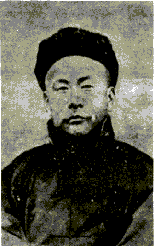The following article is the story of Master Fork Yuen Kap who was the founder of the
Chin Woo Athletic Association which was primarily a martial arts school but is now a
massive sports organisation in the far east and is slowly becoming established in this
country and Europe.
Fork Yuen Kap was born in the Xiaonanhe village on the outskirts of Tainjin. His
father, Huo Endi, was a well known boxer who served as a bodyguard for caravans travelling
to the Northeast.
The young Fork had learnt the "No trace style" from his father, though with
some difficulty. As a young child he suffered from yellow jaundice, and as such, his
father refused to teach him the family style. This was due to his father's notoriety as a
kung fu master and it would be too risky to teach such a weak child kung fu in case he
lost a fight and the family lost face. Thus his father encouraged him to be a scholar. All
the other healthier brothers were instructed in kung fu by their father, and it was during
these training sessions that the young Fork spied and practised what he saw, learning the
complete system in secret.
Some years later one of his father's rivals turned up to offer the senior Fork a
contest. This man had received a beating from Huo Endi when he was working as a guard. The
senior Fork was now fifty and had a rheumatic complaint and was unable to fight, so the
eldest sons fought for him, all were beaten and the situation became very grave. As the
challenger started to gloat the "untrained" Fork set upon him giving him a sound
thrashing, and saved the situation from deteriorating. His father was astonished at his
son's skill and bravery, and thereafter taught him all he knew. Fork Yuen Kap followed in
his father's footsteps and became a bodyguard and taught kung fu.
During the Ching Dynasty the Emperor was afraid that the Han people might restore the
Ming Dynasty. In the fifth year of the reign of the Emperor, Yung Ching made an
announcement which forbade the study of Martial Arts. Yung Ching was scared of an uprising
against him. All provincial governors were authorised to stop all practices of wushu,
whether bare hands, sticks or weapons. Anyone calling themselves a Wushu Master was open
to arrest.
As many people studied martial arts which kept them fit and strong in the process, this
prohibition caused their health to deteriorate. Towards the end of 19th century, China's
morale was low and her relationships with foreign powers were placing her in an inferior
financial and political position. Finally at the end of the 19th century the Ching Dynasty
finished and the law forbidding the practice of martial arts was lifted.
In 1906 Martial arts Master Fork Yuen Kap opened the Chin Woo Physical Training School.
The Chinese had acquired a label from the gradual invading forces of the English, German,
French and Japanese as "The sick man of Asia". Master Fork said "to
strengthen the country you must first strengthen the people!".
When he opened the first school he needed to employ many masters of different
disciplines. As each of these stylists had different objectives in their training the
early stages of setting up the school were fraught with arguments and bickering between
the masters. To get the right people teaching they had meetings to discuss and research
each Master's style and qualities. After this long period of research and discussion they
agreed to the ten basic routines which form the base style of Chin Woo. Once a student had
mastered these routines they then could become a member of the Chin Woo Association and
then progress to the more advanced styles of wushu e.g. Preying mantis, Eagles Claw etc.
Master Fork said the Chin Woo had the properties of iron and silk; soft and flowing
movements along with the strong and hard Shaolin techniques. The young members who trained
the system would have the benefit of becoming healthier, fitter and stronger, with great
levels of strength and suppleness. Older members who learn the style looked forward to
being healthier and more active in their later years with increased strength in their
internal organs.
In 1909 a strongman had arrived in Shanghai from Europe and was giving performances of
his powers, along with demonstrations he issued a challenge of hand to hand

|
|
Fork Yuen Kap
Founder of the
Chin Woo System
|
combat to any Chinese, but in Shanghai no master was strong enough to beat him. In
March of 1909 Master Fork Yuen Kap prepared to take on the European. The story goes the
European ran away when he heard Fork Yuen Kap had turned up to fight him, the other story
is he beat him in a contest. Due to the success of the contest many people came and joined
the school. Then disaster struck. Master Fork was poisoned and died at the end of August
1909. Undaunted by his death Fork Yuen Kap's disciples kept up his spirit and continued to
operate the Chin Woo school by employing the best Masters such as Chen Zhih-Zeng (Eagle
Style), Lo Kuan-Yu (Northern Preying Mantis) and Geeng Cia-Kuan (Hsing Yi).
Five years later in 1915, the members bought a new building, reorganised the school and
renamed it "The Chin Woo Athletic Association". They opened more classes and
improved some of the forms, published books and magazines. Many provinces opened their own
Chin Woo branches and in 1918 the Hong Kong Chin Woo Athletic Association was formed. In
1920, Shanghai sent five representatives to Singapore and Malaysia. They gave charity
performances all over Malaysia and now there are 14 schools in Malaysia and Singapore. The
fictionalised story of Chin Woo (Jing Wu) can be seen in the excellent movie, "Fist
of Legend" starring Jet Li.